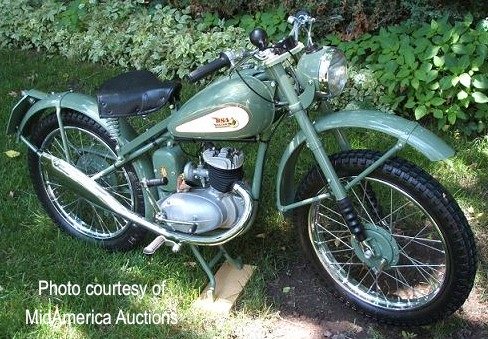BSA Bantam History
ABOVE: 1950 BSA Bantam D1 123cc.
SPOILS OF WAR
The birth of the BSA Bantam line did not take place in England after the war. Indeed it started out as a pre-war Germany design, the DKW RT125, and DKW was taken over by the Allies as part of the war reparations Germany paid after the conclusion of WWII. This same design, in fact, was also copied by Harley-Davidson, Yamaha, WSK (Poland), Voskhod (Russia) & MZ who took over the old DKW factory in East Germany.
MIRROR IMAGE
In a brilliant piece of adaptive engineering, BSA “flipped” or reversed the entire engine design, creating a mirror image of the original. This was done to move the shifter & kickstarter over to the right side, where God intended them. They also converted it all over from metric to inches & added British electrics (oh goodie!).
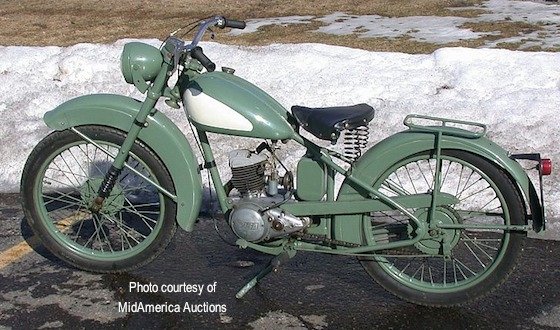
ABOVE; 1948 was the first year for the BSA Bantam. This ’48 has rigid frame.
What emerged was the 1948 BSA D1 Bantam. It shared the 58mm stroke common to all Bantams & with its 52mm bore, it displaced 123cc. The conventional 2-stroke single was unit-construction with a 3-speed gearbox. At the time of its launch, it was a thoroughly modern engine, certainly on par with the giant in the lightweight 2-stroke field, Villiers.
DESIGN QUIRKS
Bantams had a notoriously weak second gear selector that would often break & required splitting the engine cases to repair. They had a weak center stand. And those British electrics…a major source of problems throughout the Bantams lifespan. There were three options for electrical systems: 1.) Wipac flywheel magneto for spark & generator for lights; 2.) Lucas alternator & coil system (the optional upgrade); 3. Wipac magneto without but no generator, with a dry cell battery hidden in the nacelle to power the lights, or the same without the battery & lights. (competition only).
MODEL PROLIFERATION
When introduced in 1948, the 123cc D1 Bantam with rigid frame & electrics was the only model & ran in this form through 1955. But by 1950, the model-range began to widen & deepen. The D1 was soon available in either rigid or plunger frame, Wipac or Lucas electrics, Competition with rigid or plunger, & Lucas, Wipac, dry cell or no electrics, Competition with rigid or plunger. All in all, the D1 came in 8 model variations at one time or another.
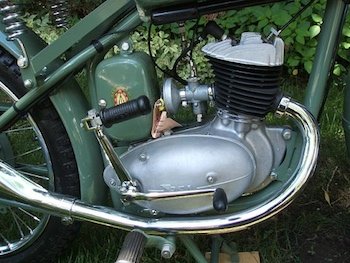
A WORLDWIDE SUCCESS
The BSA Bantam proved popular around the world. It was tough & stood up to Third World punishment, or worse, novice riders. It could run at 50mph, handled well, it had good brakes & it was comfortable. And, its color schemes & basic lines stood out in the ‘sea of Villiers-powered lightweights’ running around at the time. But as is always the case, as the model evolved, there was a quest for more power, through more displacement.
D3 BANTAM BORED TO 148CC
By enlarging the bore to 57mm, BSA created the 148cc Bantam D3 in 1954. There were two road models with plunger rear suspension & either direct or battery lighting. Competition models offered the option of either a rigid or plunger frame. D3’s also had a heavier front fork than the D1. Starting in 1956, all BSA Bantams went with a new frame with swingarm rear suspension.
D5 BUMPED UP AGAIN TO 172cc
In 1957, in the never-ending quest for more power, BSA enlarged the Bantam again, this time boring it out to 61.5mm creating the 172cc BSA Bantam D5. The D5 got a new barrel with flange-mounted carb, bigger (wider) brakes & 3.00 X 18″ tires.
D7 REPLACES D5
The D5 was only an interim step, as it was replaced in 1959 by the D7. Also a 175, it was a refinement on the D5 rather than another ‘bore-job’. The BSA Bantam D7 was listed in the 1959 catalog as the Super, in either electrical form. The engine gained an extra cover on the left to enclose both the magneto & the clutch adjuster. There were new hydraulically-damped front forks, a headlight nacelle & larger brakes in new cast iron hubs. The side panels, enclosing battery & toolbox, blended together into a center panel.
INTO THE 1960’S
At the close of the 1950’s & all the way through 1962, BSA continued to produce both 175 Bantam D7 Supers & the 125 Bantam D1. By 1963, as the market was evolving, the Japanese were invading & the public was demanding more from a motorcycle, BSA dropped the ancient D1 & to the dismay of many, planned to replace it with the BSA Beagle, a hopelessly outclassed 75cc lightweight. In 1966, the Bantam D7 went slightly upscale with it’s DeLuxe, while the economy model became the D7 Silver.
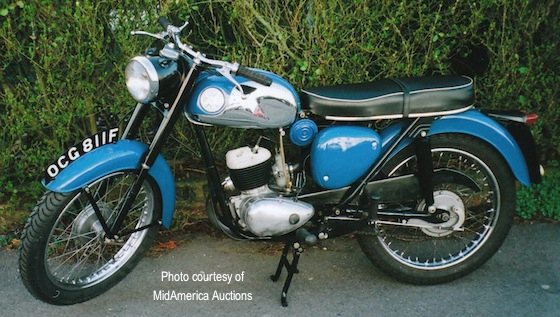
ABOVE: The 1968 BSA Bantam D14. Was it up to the standards set by Honda in 1968? Could it compete in a marketplace crowded with low-cost, high-quality 2-strokes from Yamaha, Suzuki and Kawasaki?
BANTAM D10 REPLACES D7
In July of 1966, the Bantam D7 was replaced by the substantially upgraded Bantam D10. Significant changes were made to the engine, the most obvious of which being the points cover on the primary case. There was not a 6-pole alternator which greatly improved the Bantam’s greatest weakness, it’s electrics. Early D10s carried Amal Monobloc carburetors, but quickly changed over to Amal Concentrics. Both were larger in size, which when coupled with a higher compression ratio produced more power. An additional plate was added to the clutch to cope. The D10 Silver & D10 Super retained the old 3-speed gearbox from the D7. But the new BSA Bantam D10 Sports & D10 Bushman now had a new 4-speed box, which fit in the same space as the old 3-speed.
D14 ARRIVES WITH 4 SPEEDS
The D10 was replaced by the D14 series in 1968, all of which now came with 4-speeds & a larger exhaust. A new nomenclature appeared with the Supreme being replaced by the D14/4, the Sports by the D14/4S & the Bushman by the D14/4B.
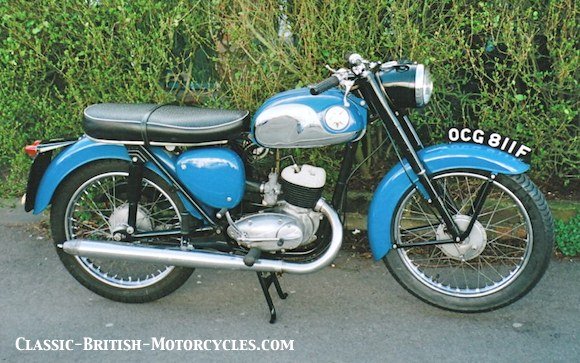
BANTAM D175: THE FINAL CHAPTER
In 1969, BSA replaced all other Bantam models with just two: The D175 road version & the D175 Bushman. Despite the financial problems BSA was having at the time, they revised the Bantam’s engine with new crankcase castings, new cylinder head with central plug, & a stiffer crankshaft.
THE SLIDE INTO OBLIVION
Hopelessly outclassed by the Japanese bikes flooding the market at the time & unable or unwilling to do anything about it, the BSA Bantam entered the 1970s looking outdated & out of place. By 1970, the only Bantam left was the standard D175 road version & by 1971, while listed in the catalog, it was essentially gone. Production ceased after over 23 years & 200,000 Bantams produced for worldwide consumption. Relevant in its day, like nearly all Classic British Motorcycles, it failed to keep up with rapidly changing times, until it was left behind by progress. Simply put, a 1970 Honda 175 or any number of 2-stroke singles & twins from Suzuki, Yamaha & Kawasaki, were faster, more reliable, looked better & probably cost less than a rickety old Bantam which still looked like a refugee from behind the Iron Curtain. As went the Bantam, so went BSA & so went the entire British motorcycle industry. Shame that.


